We try to remember that medicine is for the patient. We try to never forget that medicine is for the people. It is not for the profits. The profits follow, and if we have remembered that, they have never failed to appear. The better we have remembered that, the larger they have been.”
George W. Merck, 1950
While addressing the Medical College of Virginia the words in the quote above were used to describe a philosophy through which the medical and pharmaceutical community could be successful. Take care of the patient. Focus on the patient. It’s ALL about the consumer. If you take care of them, they will tend to take care of you. Something known well by many retailers and by most successful ones.
Regulated cannabis is supposed to provide two advantages over it’s unregulated cousin.
Regulated cannabis sales help to fund our Government through taxes instead of helping to fund unregulated providers with profits that presumably often go untaxed. These other providers are ones that authorities commonly refer to as “criminal cartels”. Choosing to be a consumer of regulated rather than unregulated cannabis (a CORC) is a choice that provides money to good and takes it away from bad.
The other advantage we are assured of regularly is that regulated cannabis is safer than unregulated cannabis because it requires testing by certified labs. Regulated cannabis has testing. It has enforcement. It has traceability. It has OVERSIGHT. Regulated cannabis is superior, and it is worthy of the tariffs and restrictions placed on it by Olympia.
Tax revenue is good and, while sales trends have been declining for 36 months, the state passed $10,000,000,000 of cumulative retail (pre-tax) cannabis sales a couple of months ago. At a current run rate of around $1.2 billion per year of pre-tax retail sales, tax revenue continues to be robust.
With regulated cannabis being safer, fewer consumer health issues are supposed to be expected because of “quality control” testing required by regulators.
I have written extensively on how this last promise is, largely, false and that CORCs in Washington state are routinely placed at risk by the cannabis they consume. The reasons for this are numerous, but they boil down to a simple fact – the primary regulatory body overseeing cannabis here is essentially a poorly-run police organization that continues to view cannabis use as something that is wrong and something that should be discouraged.
In my more cynical moments, I increasingly believe that the promise of product safety has been intentionally broken to discourage cannabis use and to, presumably, push people toward options the regulators considers safer, such as abstinence or alcohol. Regardless, it is my strong opinion that the promise that “regulated cannabis is safer cannabis” has been broken in and by the state of Washington.
Three weeks ago, excise taxes were removed from the sales of DOH-certified medical cannabis when sold to a DOH-registered cannabis patient at an LCB-licensed cannabis retailer to which a medical endorsement has been granted. The resulting exemption from some 47.5% in taxes provides a significant price reduction for fully medical product transactions and is expected to bring at least some users of non-regulated cannabis into regulated channels.
Years ago, when it became clear that the promise of regulated cannabis being well-tested and “safer” was false, I began advising CORCs to do the following when shopping for brands:
always ask to see product test results (a “Certificate of Analysis” generated by the testing lab)
be aware that, historically, not all labs seem to have produced accurate COAs
do some research and get to know a grower or growers that seem worthy of your trust.
I would offer the same advice today, but I would do so knowing that very few stores can reliably produce a COA that actually corresponds to the lot(s) from which the product on the shelves arose, that labs that I consider to be questionable conduct the majority of testing in the state today, and that going through all of the data and information and websites and focus groups and workshops and opinion and, often, bullshit that permeates the industry is not easy.
I have spent the better part of the last 9 years looking closely at the data spit out by our cannabis market and recognize that my last “ask” can be a challenge. Fortunately, I have familiarized myself with much of the data related to product safety and, through that work, have increasingly come to focus my attention on issues relating to consumer protection and safety. Those are issues that are pertinent to all CORCs but are likely even more so to patients using cannabis as part of their medicinal / nutritional regimes.
My concern regarding the largely failed promise of product safety in this market is amplified by the possibility that many folks that use cannabis medicinally and currently source their meds through unregulated channels may be attracted to the price discounts afforded by tax-free medical cannabis. Having ignored the regulated market for almost a decade, I suspect that many of these potentially vulnerable consumers will be ignorant of some of the regulatory and enforcement problems that pervade the market and may, blindly, assume that all regulated product is “safe, since it has (allegedly) been tested”.
To the extent that you are concerned enough about the safety (which I’d argue correlates very well with the QUALITY) of the cannabis you consume, I thought I’d provide some assistance in the form of a grouping of retail access points in terms of the “mix of suppliers” that they carry on their shelves (categorized by the “consumer safety” metrics I describe below).
What follows is a listing of what I believe the data suggest to be the “best” and the “worst” of stores from a product and, hence consumer, safety perspective. I’ll briefly explain what I did so that you can gauge your level of agreement with the information I’m about to supply and the degree to which you might want to use it in your purchasing decisions. You, as always, decide for yourself. I’ll try to address any questions you have if you leave them as comments on this blog post. I do not intend to engage at all on social media about this work.
This article was instigated by a friend not familiar with the regulated market asking me which regulated farms produced product that I felt was safe for patients to purchase and use. I initially told them what I generally say to such folks: YOU CAN’T GO WRONG BUYING FROM ONE OF THE FEW VENDORS THAT PRODUCE DOH-CERTIFIED MEDICAL PRODUCT. That product is tested to higher standards and the very few vendors that embraced the DOH certification were their best bet.
As of early this year, the vendors that I believe fell into that category were: Trail Blazing Productions, Skagit Organics, and Fairwinds Manufacturing. These are all good brands that I’d recommend if I were into recommending brands. I would also give a nod to Washington Bud Company who was, I believe, the first grower to have all of their product certified to DOH medical standards. They did so for many years, but left the program a few years ago when it became clear that the vast majority of medical cannabis patients were not participating in the “DOH-certified” medical space. I’d also be quite comfortable recommending their products. They are also one of the few producers left that is, reliably, producing traditional medical strains.
There are a handful of companies that, over the years, have tested some of their product lines to DOH standards, but none that have gone all-in like the ones I named above. I understand that WA Bud Company has recently begun testing all of their product to DOH standards once again.
With the creation of tax-free medical cannabis quite a few more growers are beginning to test to DOH standards. Quite a few more stores have recently begun to embrace the “medical endorsement”, which seems a bit late given that the 8th anniversary of medical being regulated is this coming Monday. It has also come to my attention that medical testing volume in the two labs that can do heavy metals testing (which is only required for medical cannabis product certification) is up quite substantially.
Presumably, tax-free sales to registered patients are also increasing.
At the end of this post, I will provide some links that should help you to identify wholesalers that have recently begun getting at least some of their products certified as “DOH compliant”. My goal today, however, is to provide some information that may be helpful for folks trying to find “safer” product as defined by the behavior and choices of wholesale licensees in the years BEFORE this new revenue-generation opportunity arose.
What follows is a county-by-county listing of the “best” and the “worst” stores defined by the farms (processors) they do business with and the relative expected “safety” of the product produced by those farms. I compiled all of the data I could think of that potentially related to the safety of the product produced by each farm and produced a farm-specific metric that describes their “safety”. That metric includes information related to heavy metals risk, pesticide risk, adulteration risk, “safe sourcing” risk, and lab-reporting-risk – all tied to the farm (producers and/or processors) in question.
I scored every farm in the state on each of these dimensions, using publicly-available data, and ended up with a single score describing each farm that is coined in terms of a percentage. Every farm starts out at 100% and has that percentage incremented for safety-promoting things (e.g., having tested for heavy metals, which very few farms do, or using a “good” lab to do their testing) and decremented for safety-inhibiting things (e.g., having your farm located directly on top of DOE-indentified legacy orchard lands with their likely historic use of the now banned pesticide lead arsenate — and maybe even DDT).
When the factors were all added (and subtracted) up, each farm was left with a remaining percentage, which could range anywhere from – 42% to +160%.
To make that more concrete – here is an example of the scoring done for the 3 “legacy regulated medical” suppliers that were still producing pretty much exclusively DOH-certified product as of the first quarter of this year. They all scored well and received 5-star or 4-star ratings. For balance, I have included the 3 suppliers with the lowest scores in the state. Most of the data I used go through March of this year and roughly correspond to the period during which CCRS has been active (since 2022). As such, they are a reflection of how the farms were (and by extension, the purchasing preferences of the stores) at that time and over the measurable history each license carried with it across the years.
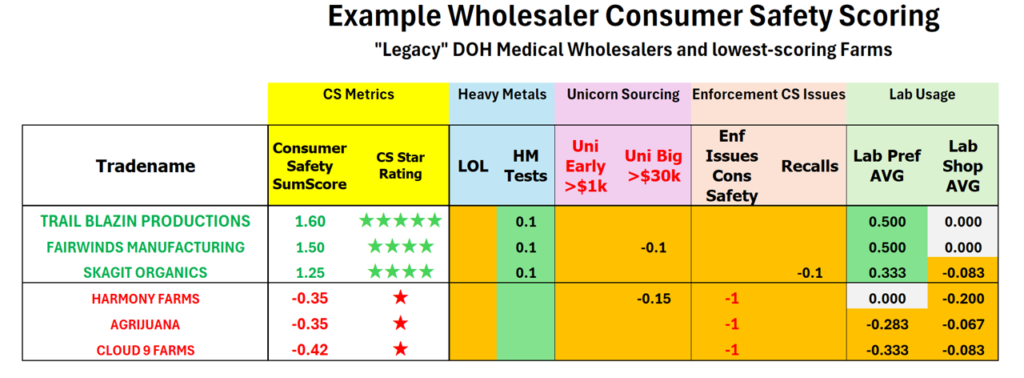
Trail Blazin Productions was one of the farms that got the maximum score of 160%. That reflected their choice of testing lab, the fact that they test for heavy metals (as do ALL farms going for DOH product certification), and their lack of any consumer-safety-related enforcement issues over the past decade. The farms at the bottom of the list have each received multiple pesticide and/or “adulterating product with organic or inorganic chemicals” notices (AVNs, NTCs or Warnings) over the years.
In general terms, farms were assigned positive factors for testing for heavy metals and for choosing one of the SUPERIOR testing labs (Medicine Creek Analytics and Confidence Analytics) to test their product or for choosing a GOOD lab (Capitol Analysis) to test their product. Negative factors were assigned to farms for using any other lab, for being situated either ON TOP OF legacy orchard lands (LOLs – as identified by the Dept. of Ecology), or within 1,000 feet of LOLs, for being an early significant purchaser of UNICORN raw materials or a significant ongoing purchaser of their raw materials before the LCB shut down the operation, for having any issues with LCB Enforcement regarding product safety (specifically, having any AVNs, NTCs, or Warnings for any of the pesticide violation categories or the “adulterating product with organic or inorganic chemicals” violation category). My metric assigned a negative 100% weight to any farms that had 3 or more such issues with enforcement. Negative factors were also assigned to farms that the LCB has reported as having undergone one or more product recalls for pesticide reasons. The final negative factor is applied when a farm chooses to test with multiple labs.
Across the years, farms have changed ownership. Farms have changed location. Farms have changed their names. Farms have changed strains and product lines. Farms have changed growing and processing practices.
All of that change can impact how well the historical data reflect upon current farm operations and product output. So — take all of this with a grain of salt, but also take note that quite a bit of data were used in making this evaluation and, ultimately, it is the DATA doing the talking.
Here is the distribution of raw Consumer Safety (CS) Scores earned by the population of regulated farms:
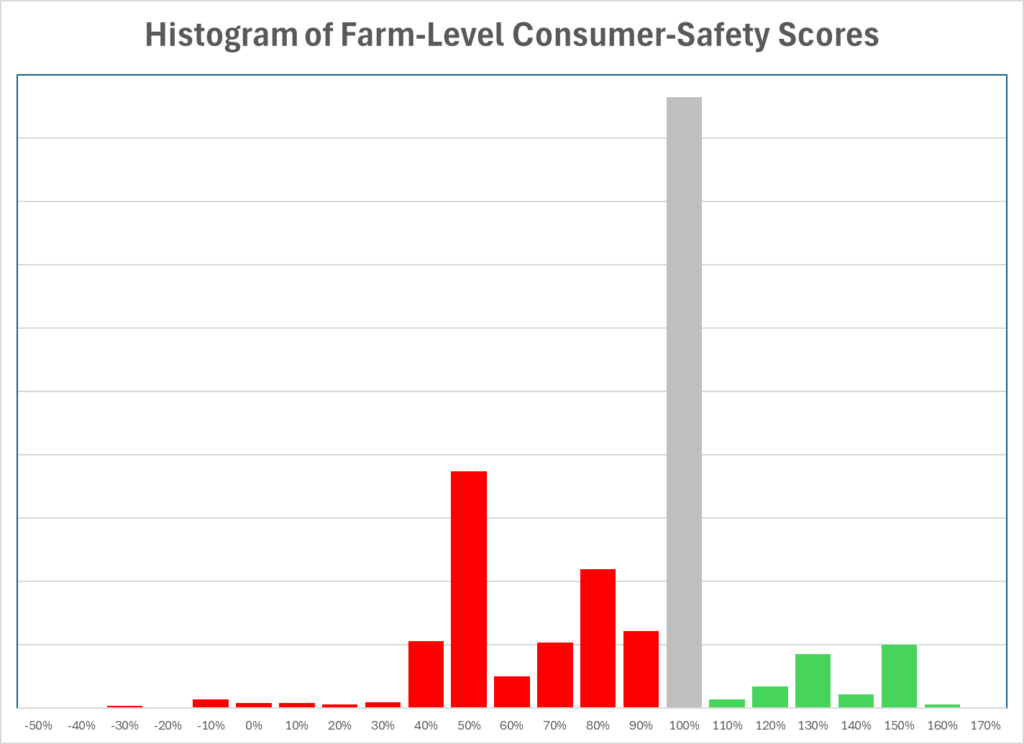
All of the transactions in which wholesalers transferred product to retailers (between August of last year and March of this year) were then multiplied by their CS Score and the rolled up weighted total was divided by the non-weighted total of transactions. If all of the suppliers for a given retailer had a CS Score of 100%, then the retailer would have a score of 100%. If ½ of the SKUs a retailers received came from suppliers with a CS Score of 100% and half from suppliers with a CS Score of 80%, then the retailer would have a score of 90% (etc).
In the real world, retailers typically have quite a few suppliers and it’s unlikely that they will all have the same CS Score. When the hundreds of shipping wholesalers are rolled up into the hundreds of receiving retailers, here is the resulting distribution of Retail store-level CS Scores.
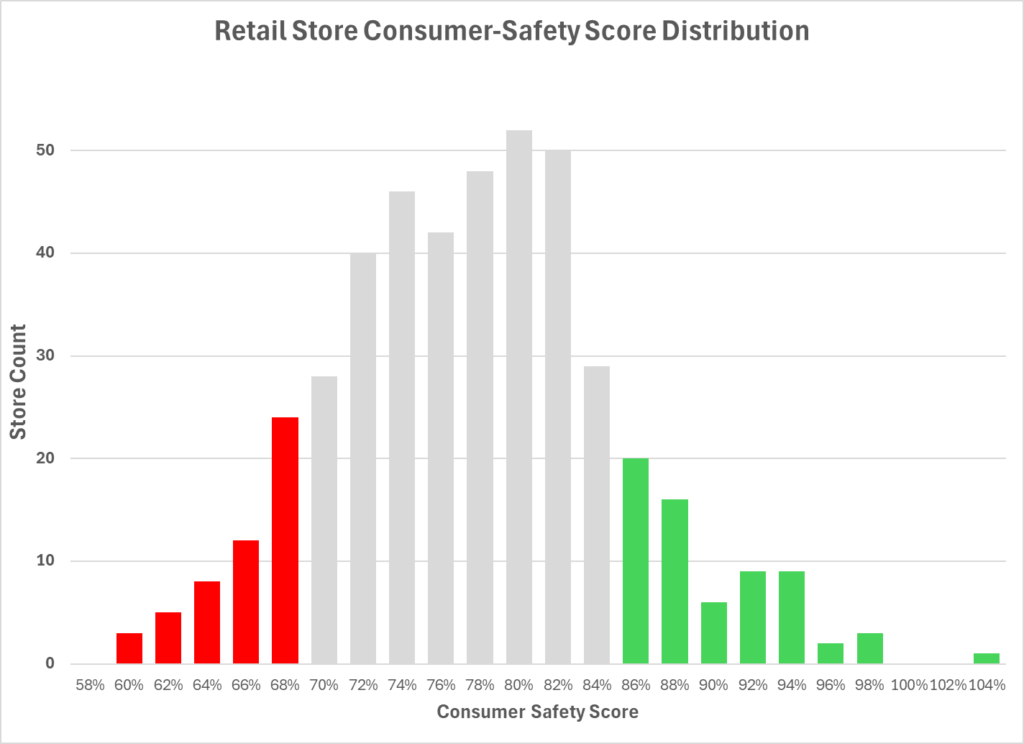
As one might expect from the central limit theorem, this multi-input metric tends toward being a bell-shaped distribution. The resulting retail CS Scores span a range from 58.2% to 102.4%. I would be remiss to not point out the store at the very far right of this distribution.
I was very surprised to see a store with a CS Score of over 100%. Given how many of the farm-level scoring factors yield negative scores and how more farms have negative scores than positive ones, seeing a positive store-level CS Score suggests that this store is choosing it’s suppliers with (IMO) consumer safety at the forefront of their purchasing decisions. That would (again, IMO) tend to lead to them having a higher QUALITY of product on their shelves. I suspect this store has done what I often advise CORCs to do. I suspect they have done their homework, they have looked at COAs and compared them to the stuff in the package and they have built trusting relationships with quite a few good high-CS-Scoring farms. But that is just me guessing.
If you find yourself in the Seattle area, you may want to check that store out – it is Canna West Seattle, located at 5440 California Avenue SW in West Seattle. Seriously – they are doing something “right” down there to get a number over 100% on this metric. I was honestly and truly surprised. They are almost 5 percentage points ahead of the next “5-star” store in the state. Amazing.
I love numbers and enjoy, for example, pondering the distinction between scores of 0.42344 and .163777. I have come to recognize, however, that most people prefer pictures to numbers. Hence, I grouped the stores across the state, based on their rolled-up CS Scores, into a 5-star rating system, in which 5-Star stores are those with the highest CS Scores (and, likely, higher quality product) and 1-Star stores are those on the other end of the CS-Score spectrum.
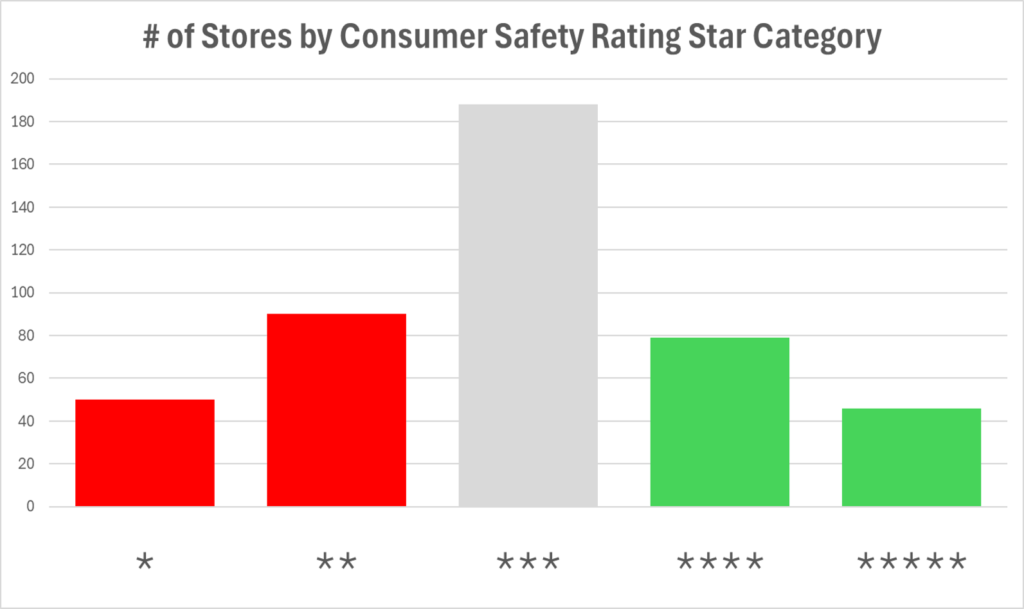
As you can see, the majority of stores fall into the 3-star category. I refer to them casually as “The Mids”. I honestly think you will, on average, find safer product and product of higher quality in stores with more stars on this scale than you will, on average, in stores with fewer stars.
To that end, here is the main content of this post. The following seven tables list all retail access points in the state that have achieved CS Scores that merit 5-Star, 4-Star or 1-Star labels. The stores are sorted within each county in descending order by their underlying CS Score. Hence, the first store listed in each county is the store with the highest CS Score in the county.
In counties that did not have any 4-Star or 5-Star stores, I occasionally included that county’s top-scoring 3-Star store.
I’m not going to comment on these tables. Higher position within a county means a higher CS-Score for that store. More stars means higher CS-Scores than fewer stars. Green is the color of the old crosses from the medical days. Red is not. Grey is the fence-sitting thing that grey so often is. I hope you find this useful.
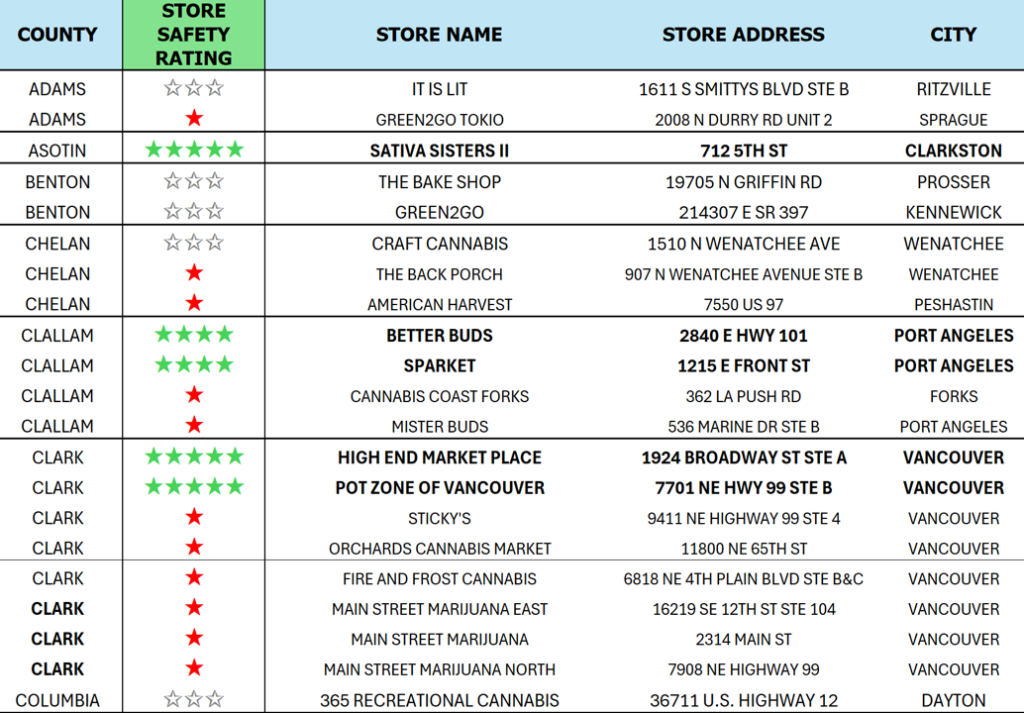
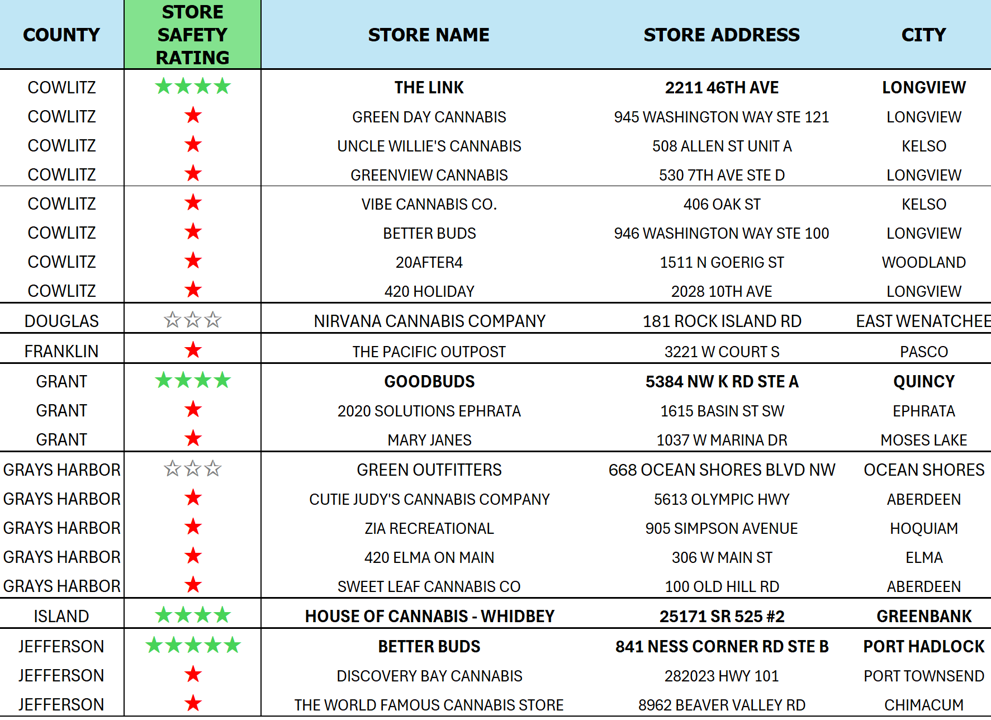
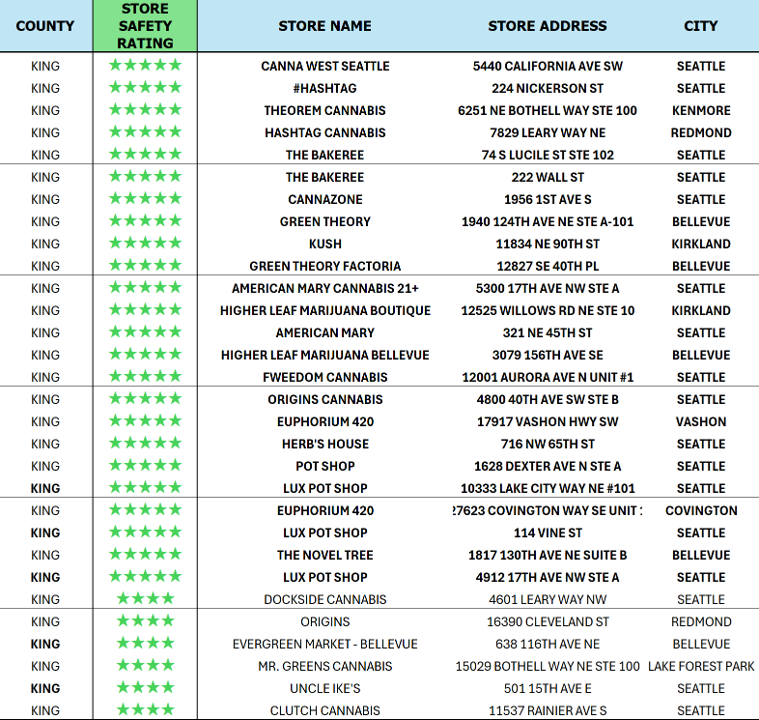
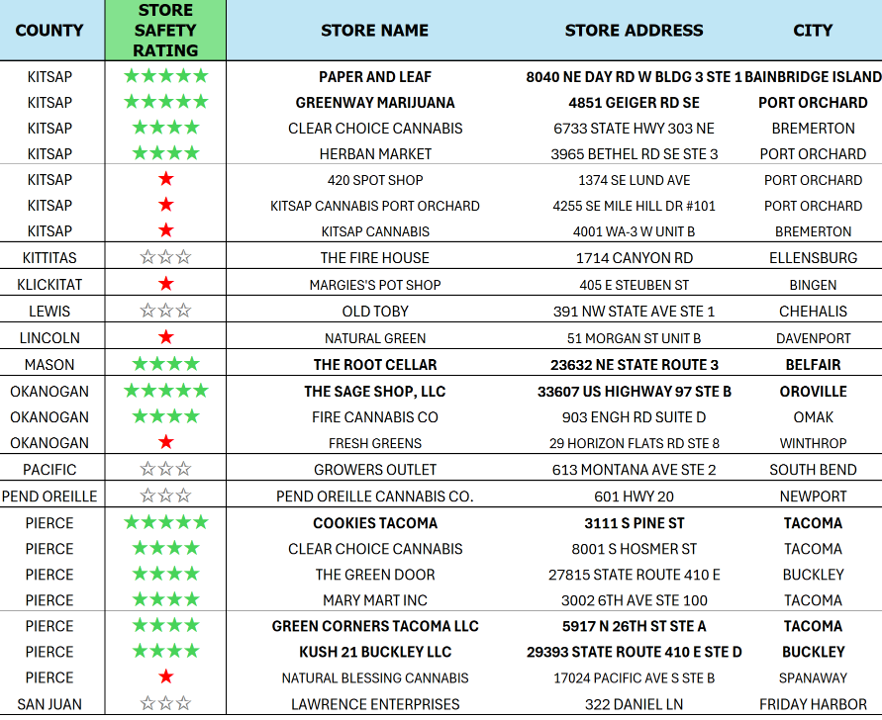
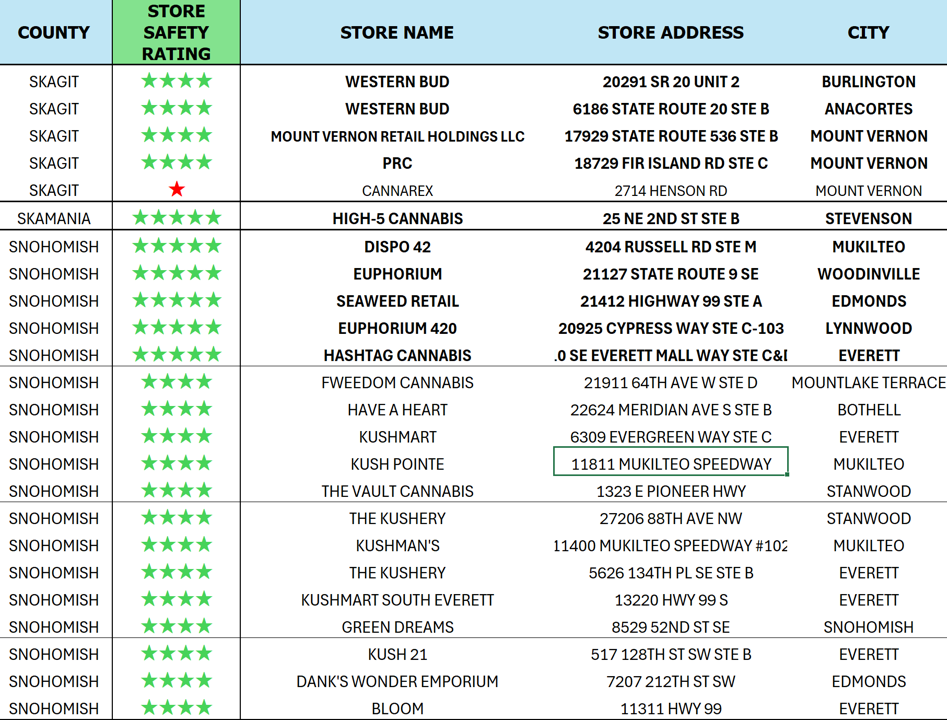
I sincerely hope that the above information helps you to shop at better stores and acquire safer and better products if you are a CORC or considering being a CORC.
If you are a patient attempting to acquaint yourself with the regulated market, and would like to find safer product, 4-Star and 5-Star stores would likely be better places to shop. If you want to find a store that has focused more on regulated medical sales, check out the list I put together last summer.
Canna West Seattle looked good on that list, as well, so if you want both to be served well as a patient and also be offered a selection of what appears to be very well curated products, then I’d suggest you think about making a trip to their location.
The best source I’ve seen to identify wholesalers that are beginning to test to DOH standards is the “Certified with Confidence” site, in which one of the two best labs in the state (Confidence Analytics —- Medicine Creek Analytics being the other of the two) has posted the farms that have signed up with their program. I’ll let you read the details on their site, but it looks well-designed and informative (and supplies live links to the brand websites if you click on the logos).
Going forward, some of you may have noticed that, while this article was instigated by a friend asking about producers of safe product, my producing a list of stores did not directly answer their question. Having already created a CS-Score metric for each farm, it would be easy to categorize all of them into “Star Groups”, as I did with the stores.
I will likely share at least some of the individual farm-level data with that person and, after thinking about it awhile, with a handful of other folks that might be able to not only put it to good use, but also provide me useful feedback to help make future farm profiles more accurate and useful.
The reason that I’m not going to publish a farm-level list at the moment is that the data can get fairly thin down there and a single event (e.g., having an LCB officer punish you with a product recall for whatever reason they decided to punish you) should not have the potential to be terminal to your business. The “noise” in the data at the farm level tends to wash out when hundreds (and thousands) of transactions are rolled up to the store. When one sees big differences in stores that have been scored with such rollups, that truly suggests that something is different about their product sourcing strategies in a way that makes one more product-safety-centric than the other. At the level of the individual farm, it could just be dumb luck.
Let me know what you think of this.
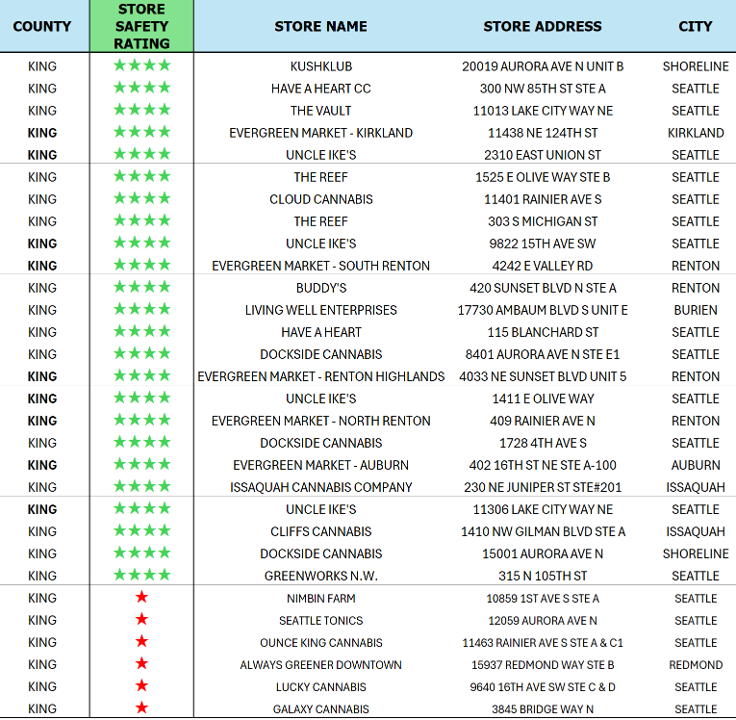
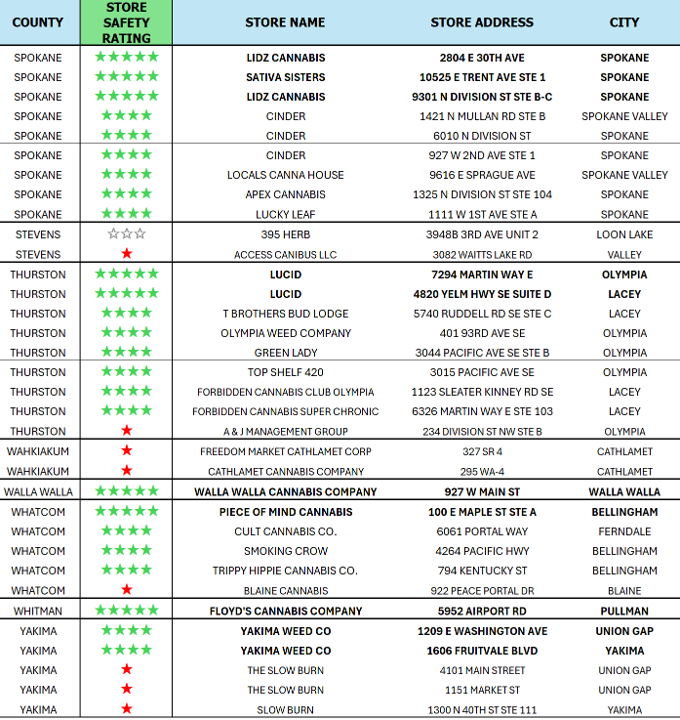
Hi Jim. Some quick hits.
First, you should know that Agrijuana is exiting the Washington market effective end of June i.e. a couple of days from now.
Second, the fact that test results aren’t actually connected to specific lots, and that DOH certification is simply some additional tests, makes it a bad idea to rely on testing to be any indicator of quality or safety.
Third, the medical system in Washington state is a privacy nightmare, which is why my shop has never participated. There’s no reason for this other than Washington state DOH, DOR and LCB being lazy. Linking specific purchases over periods of time to a specific individual when the purchases are for a federally controlled substance is just idiotic. It’s illegal for any cannabis user to own a firearm. Use of cannabis can be determinative in things like child custody hearings, or in disputes between business partners. The idea that retail shops — many of which who can’t even protect their inventory — are keeping sensitive individual data on hundreds or thousands of customers, and by law, they have to keep it forever — well, the whole system is absurd.
Finally, we all know the DOH testing is expensive, and as a result, from a quick breeze through your data, it’s not surprising to me that many of the five star stores are exactly that, expensive stores and often in fancy neighborhoods, when the one star stores are often shops that carry less expensive product. The unfortunate reality is the majority of cannabis by weight in this state is the cheaper stuff, it’s the product that moves in large quantities.
Anyhow, it’s an interesting article, I appreciate your efforts.
(Side note: “Galaxy Cannabis” on Bridge Way has never opened. I find it interesting that you have them down as a one star. This facility is only a few blocks from my shop and I walk by it probably ten times a week and I have never seen it open, it has no signage, no hours, nothing. So, I’m not sure how that ended up on your list, as they can’t have had any sales… I think they still don’t even have legal permitting from the City of Seattle, something about a dispute regarding handicapped parking.)
Hi Jim,
Interesting stuff as always.
It sounds like several of the cannabis stores I usually shop at probably have CS-Scores in “The Mids”. Might have to check out Lucid in Lacey sometime. Thanks for the tip about Canna West Seattle, sounds like it would definitely be worth a visit when I’m in the area.
You mentioned that Medicine Creek Analytics (tribally-affiliated cannabis testing lab) is one of the superior testing labs. Are testing results for tribal cannabis farms available from tribal stores? Did your list include CS-Scores for any of the tribal stores?
Best wishes.
I believe most (or all) of the tribally-owned stores are missing from the dataset I used to create the lists of stores I published here.
The LCB has a strong tendency to remove tribal entities from their publicly-visible datasets.
Those entities also do not report all of their data in the same way that non tribally-owned stores do.
IF any had made it through my licensee-identification merges and then failed to merge into any of the other datasources from which I pulled the +/- multiplier factors, they would have received a default multiplier for that factor of 0.
I always biased “errors” in favor of placing the stores closer to the middle of the distribution (giving them a zero-multiplier for everything would ensure they got a final score of 100%, which would ensure that they were categorized as a 3-Star store.
I checked for the 3-4 tribal stores I know off the top of my head and none of them were in there.
Medicine Creek Analytics in Fife (3700 Pacific Hwy E #400, Fife, WA 98424 … (253) 382-6900) is my favorite lab. I like CONFIDENCE Analytics very much as well (same level of certification, also have HM testing capability, and they do good things related to informing and education about lab testing issues). MCA’s affiliation is not only with the tribe, but their co-location with a clinical practice and their higher-than-normal level of certification (ISO something) and their embrace of heavy metals testing BEFORE IT WAS REQUIRED all contribute to how I view the lab.
I don’t know if tribal stores hold COAs, but hope (and assume) they do. I DO know that many of the non-tribal ones are next to worthless at being able to produce one upon request.
One thing I do know is that MCA is extremely cautious about releasing testing information from their clients. I’ve found their client confidentiality position to be a little problematic in getting specific types of information from them, but I certainly respect how THEY respect their clients’ confidentiality.
I believe they follow all of the rules regarding posting stuff to CCRS, but CCRS is essentially broken when it comes to trying to trace product vs it’s testing results.
For folks that get bothered by acronyms, I always try to define them when I first use them in an article.
Here is a list of the ones used here, with their meanings
CORC = Consumer of Regulated Cannabis
AVN, NTC, WW = Enforcement “Administrative Violation Notice”, “Notice to Correct”, “Written Warning”
DOH, LCB = “Dept of Health”, “Liquor and Cannabis Board”
CCRS = “Cannabis Central Reporting System” – the largely dysfunctional seed-to-sale “traceability” system
LOL = “Legacy Orchard Land”
CS Score = “Consumer Safety Score”
COA = “Certificate of Analysis”
Hope that helps.
Great work, Jim!
Thank-you, Allison. I hope you find utility in it.
Hello Jim, I like many others find your information very useful. I am also shocked to find someone has already done what I wished someone like myself could succeed at doing in my own state. I am trying to help keep cannabis products safe in my state and am hoping to connect with you to find about better ways of doing that. I noticed you didn’t have a page on LinkedIn so I couldn’t connect. Thanks again, and hopefully you see this!
Well … been awhile since I looked at my BLog site. I appreciate your kind words.
I AM on LinkedIn, but am not particularly active on the site. I am transitioning out of the workforce and am trying to avoid most forms of social media going forward.
If you ask for a connection on LinkedIn, mention that you are the person that wrote this comment, and I’ll be more likely to accept your request.
Cheers!